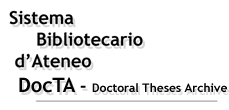|
|
DocTA - Doctoral Theses Archive >
Tesi di dottorato >
CORSO DI DOTTORATO IN MODELLI QUANTITATIVI PER LA POLITICA ECONOMICA >
Citazione:
Utilizza queste indicazioni per citare o creare un link a questo documento.
|
Cornaro, Alessandra. "Newkeynesian models for monetary policy analysis under stycky prices: a nonlinear approach", Università Cattolica del Sacro Cuore, XX ciclo, a.a. 2007/08, Piacenza, [http://hdl.handle.net/10280/634].
|
| Titolo: | Newkeynesian models for monetary policy analysis under stycky prices: a nonlinear approach |
| Autore/i: | CORNARO, ALESSANDRA |
| Tutor: | AGLIARI, ANNA |
| Coordinatore: | BAUSSOLA, MAURIZIO LUIGI |
| Lingua: | ENG |
| Abstract in italiano della tesi: | La tesi è organizzata come segue: nella prima parte viene presentato il background matematico necessario per studiare il modello, introducendo la nozione di sistema dinamico (capitolo 2). Succesivamente viene introdotto il background economico, con il concetto di determinatezza sia dal punto di vista tecnico, con esempio applicativo, che dal punto di vista dei modelli presenti in letteratura in cui viene impiegato. Nella seconda parte viene presentato il framework analitico, basato sul modello di Woodford. In seguito, si passa studiare il modello con lo strumento della loglinearizzazione, fornendo le relazioni di equilibrio attorno allo stato stazionario. Poi si specifica il modello in un caso particolare e si prosegue per ottenere la versione non lineare del modello, introducendo nuove ipotesi compatibili con il framework analitico, in modo da poter studiare la determinatezza dell'equilibrio. |
| Abstract in inglese: | The thesis is organized as follow: we start presenting, in the first part, the mathematical background we need to study our model, introducing at first the notion of dynamical system, more specifically in the discrete time, as our model required (Chapter 2).
Afterwards, for the economical background (Chapter 3-4), the concept of determinacy of the equilibrium is analyzed from the technical point of view for linear models, providing the analytical conditions that let us obtain a unique and determinate equilibrium.
Once explored the techniques, we give an exhaustive example that allows us to better understand from the mathematical point of view the concept of determinacy and how it is linked to the concept of stability. After that, a brief survey of the models that involved the study of determinacy is exposed, showing the several fields of application.
Then, since in our model of monetary policy we imply different interest-rate policy rules in order to study the stability of the macroeconomic system, we provide a short preamble of the rules for the operating target interest rate set by Central Bank.
In the second part the analytical framework is presented. The starting point is a model for price level determination in a cashless economy, where nominal rigidities are introduced, based on Woodford's work and we give the equilibrium relations of the model in the implicit form (Chapter 5).
Afterwards, we build the model in a particular case (Chapter 6), by specifying the functions involved in the model by using utility function of C.R.R.A. type and linear production function, compatible with the analytical characterization. In this way we get the components of a general economic equilibrium model, consistent with the optimizing behavior of households and firms. The results obtained after the specification of the functions are the same we can find in the analysis proposed by Walsh.
At this point, we obtain the log-linearized version of the model that is the starting point for the study of the stability of the system in the linear case.
This procedure let us find a two equations forward-looking and rational-expectations model for inflation and the output gap.
Then we briefly present the different policy regimes used in the analysis according to our framework, providing the interest-rate relations that close the model
Since our intention is to find a nonlinear version of the model, the step of using the log-linearization is essential in order to understand and to underline how this tool is useful not only for studying the equations around the steady-state but also to make these relations more treatable from a mathematical point of view: in fact it is important in order to figure out the obstacles we faced to build the nonlinear model and to find the solutions proposed in this work.
In the third part (Chapter 7), to reach our purpose to go beyond the log-linearized and simplified version of the model, we try, under some assumption compatible with the behavior of the agents, to provide nonlinear conditions for this model. This is meaningful in order to avoid loss of informations due to the limited analysis around a neighborhood of the steady-state.
Once illustrated the nonlinear model and the equilibrium relation, we study the determinacy of the equilibrium, using the techniques shown in the first part, under two different interest rate specifications that close the model. Chapter 8 concludes. |
| Data di discussione: | 9-giu-2009 |
| URI: | http://hdl.handle.net/10280/634 |
| È visualizzato nelle collezioni: | CORSO DI DOTTORATO IN MODELLI QUANTITATIVI PER LA POLITICA ECONOMICA
FACOLTA' DI ECONOMIA (SEDE DI PIACENZA)
|
File in questo documento:
| File |
Dimensioni | Formato | Accessibilità |
|---|
| testo_completo.pdf | 567,06 kB | Adobe PDF | non consultabile
|
|
Accesso e utilizzo dei contenuti di DocTA
|



